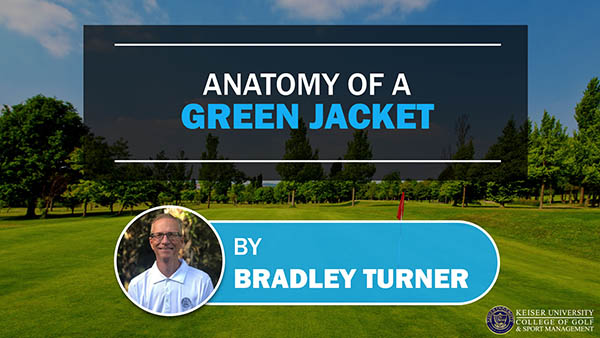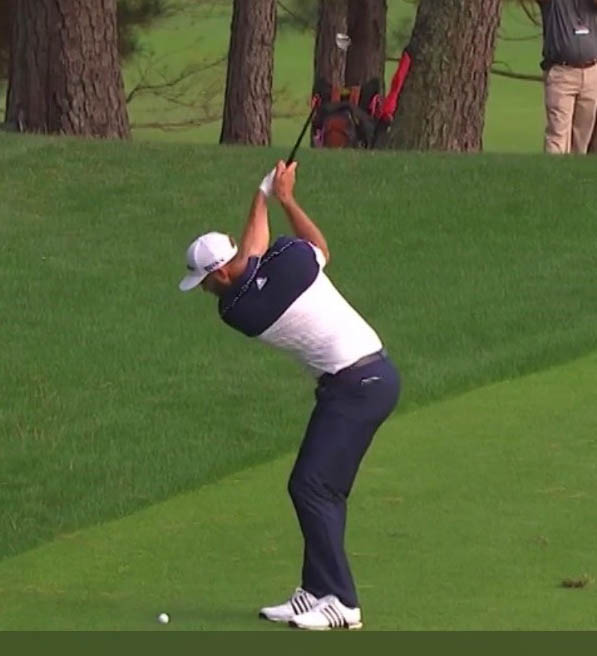Anatomy of a Green Jacket

By Bradley Turner MBA, PGA
Director of Online Golf Instruction, Keiser University College of Golf
Another Masters Tournament is in the books, with Dustin Johnson putting on the Green Jacket for the first time. Johnson was not a surprise winner at Augusta National, where the long hitter has always had an advantage. This year was once again favorable for the power-player, with the course playing longer than its stated yardage. This emphasis on length will continue to be in the headlines for the foreseeable future. Bryson DeChambeau did not perform well as the tournament favorite, but his power is an advantage. As DeChambeau found out last week, Augusta National will continue to defend itself against the best in the world and will always require much more than brute strength for the next champion.
Power by the Numbers
Looking at the 2020 driving distances of the top seven finishers this past week, it is no surprise that distance is their ally. Of special note is Dylan Frittelli, who was 146th in the 2020 season but is now 20th in driving distance in the 2021 season. He has increased his distance off the tee by 22.4 yards.

Does Augusta Require Right to Left Tee Shots?
Conventional wisdom for success at Augusta National has been for the players to hit a right to left shot from the tee. But that wisdom is no longer as important as it once was when players were trying to gain every yard they could from a right to left tee shot. Holes that historically favored a right to left shot include 2,5,9,10,13 and 14 at Augusta National. However, today’s players are hitting it so long that they no longer need to alter their preferred ball flight to have success at the Masters. Johnson hit almost exclusive fade tee shots this past week with a few blended fairway metal draws. Jack Nicklaus always believed that Augusta National was a second shot golf course. Position off the tee made it easier to execute the second shot was his thinking, and who better to listen to than the six-time champion. The takeaway from last week: position is more important than distance.
If You Have a Wedge Game, You Can Compete at the Masters
 Once you are in a position to approach the challenging hole locations, the player must be able to control the distance of their irons. Johnson has been great when hitting a full stock iron shot into the green but has struggled with taking distance off his irons. Johnson has such a long and powerful swing; he will continue to have challenges keeping his distance wedges under control. This is an area where he has worked to improve his rather poor PGA tour proximity rankings from 50 yards to 125 yards. Over the last 10 years, he has enjoyed mixed success, which indicates the difficulty he has in controlling his wedge distances. The other challenge with his swing dynamics is the degree of bowing in his left wrist. We have seen very few great players with as much wrist flexion (bowing) as Johnson. However, many players bow the lead wrist to some degree at the top of their swing. The picture here is an 82-yard shot. He has so much power stored in that position; it would be difficult to take distance off the golf shot.
Once you are in a position to approach the challenging hole locations, the player must be able to control the distance of their irons. Johnson has been great when hitting a full stock iron shot into the green but has struggled with taking distance off his irons. Johnson has such a long and powerful swing; he will continue to have challenges keeping his distance wedges under control. This is an area where he has worked to improve his rather poor PGA tour proximity rankings from 50 yards to 125 yards. Over the last 10 years, he has enjoyed mixed success, which indicates the difficulty he has in controlling his wedge distances. The other challenge with his swing dynamics is the degree of bowing in his left wrist. We have seen very few great players with as much wrist flexion (bowing) as Johnson. However, many players bow the lead wrist to some degree at the top of their swing. The picture here is an 82-yard shot. He has so much power stored in that position; it would be difficult to take distance off the golf shot.
But this last week, Johnson was certainly better than his historical average from 50-125 yards. In fact, his wedge game from this distance at the 2020 Masters was better than his 2016 season average of 16’ 0” when he ranked number 4 on the PGA Tour. We do not have a comparison stat for all the players that competed in the Masters, but it is safe to say that his wedge game was dialed in for the week. The data seems to suggest that power is an ally but controlling the distance of your approach shots is paramount in winning a Green Jacket.

Even if you do not hit the ball at least 300 yards, you can compete just about anywhere if you have a great wedge game from 50-125 yards. Bernhard Langer, at the age of 63, finished T29 (-3). How did he play so well when he averaged only 260 yards off the tee?
 The par 5’s at Augusta are opportunities for the long hitters to reach the green in two with the potential for an eagle. Johnson hit 5 of the 16 par fives in two, converting two into eagles. For the week, he played the par 5’s at 11 under par. Langer played the par 5’s 8 under for the week. He never reached any of the par 5’s in two strokes, yet he only lost three shots to Johnson. For the week, Langer had 17 opportunities to get up and down from 50-125 yards. He converted nine of the 17. His proximity to the hole was an astounding 13’ 3”, including a very poor shot from 50 yards that finished 51 feet from the hole. Remember, the PGA tour average is about 18’ 9”, so on 16 of the 17 wedge shots, he averaged inside 11 feet. If you have a wedge game, you can compete anywhere!
The par 5’s at Augusta are opportunities for the long hitters to reach the green in two with the potential for an eagle. Johnson hit 5 of the 16 par fives in two, converting two into eagles. For the week, he played the par 5’s at 11 under par. Langer played the par 5’s 8 under for the week. He never reached any of the par 5’s in two strokes, yet he only lost three shots to Johnson. For the week, Langer had 17 opportunities to get up and down from 50-125 yards. He converted nine of the 17. His proximity to the hole was an astounding 13’ 3”, including a very poor shot from 50 yards that finished 51 feet from the hole. Remember, the PGA tour average is about 18’ 9”, so on 16 of the 17 wedge shots, he averaged inside 11 feet. If you have a wedge game, you can compete anywhere!
If you’d like to study with Bradley Turner and other PGA Master Professionals, contact The College of Golf today.














